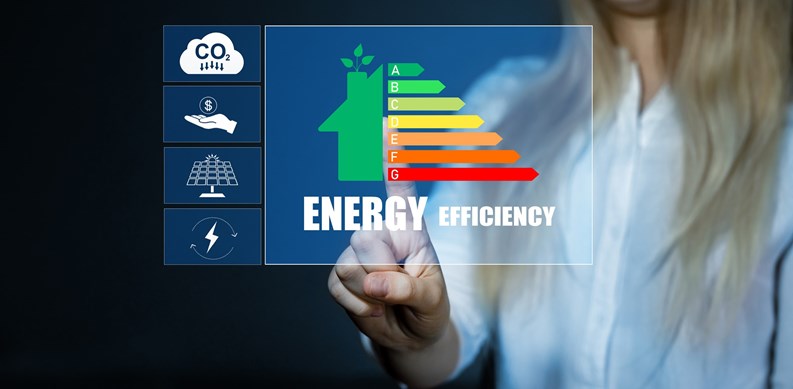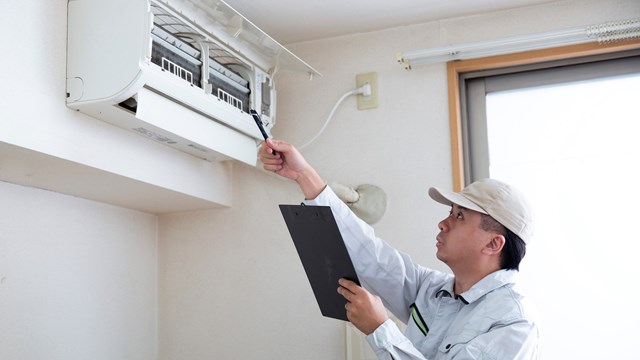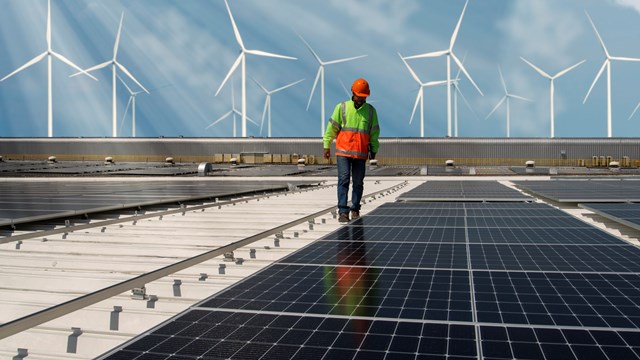Reducing energy waste and saving money go hand in hand. In addition to helping the planet, using energy more efficiently can save time, lower bills, and improve daily life. In fact, according to a joint report by the American Council for an Energy Efficient Economy and Physicians for Social Responsibility, energy efficiency measures could help save six American lives every day, and avoid up to $20 billion in health care costs each year.
In condos, co-ops, and HOAs, even small changes can make a big impact on the environment—and on shareholder’s wallets. There are only a number of costs you can control, but energy is one where management, trustees, and residents can cooperate to save their communities serious money.
Know Your Systems
Condo associations and HOAs come in many shapes and sizes, just like people. Knowing what type of HVAC equipment is in use on your particular property is crucial to optimizing its performance and maximizing its useful life.
“There are high rises, low rises, townhouses and stand-alone buildings,” says Jack Carr, retired senior vice president of engineering for Criterium Engineers in Portland, Maine. “Some have more sophisticated equipment, and some don’t. If you have an 80-year-old, four-story apartment building in Cambridge that has a steam boiler in the basement and has all radiators upstairs they’re going to have different heating issues than a modern townhouse complex that has brand new, high-efficiency units. You have to check what you have and go from there.”
2: Work Together
As mentioned earlier, whatever strategy your community wants to put into effect, it will work best if your board, manager, and residents work together toward a common goal. “There’s not enough money in the world to get your building’s emissions to absolute zero,” says Jimmy Carchietta, the self-proclaimed ‘Greenfather’ and founder of sustainability consulting firm The Cotocon Group, “but there are things every manager and resident can do to get closer. Teaming up to learn about how to tackle energy reduction can make the biggest difference”
Carchietta suggests taking a look at what you can do as a group, like forming an energy conservation or sustainability committee within your building or HOA, and what you can do as a community to save money. “Maybe it’s working together to buy air conditioning units in bulk, or agreeing on rules for how often you run them,” Carchietta says. “If you have more efficient units, you should be able to run them less often.”
3: Pay Attention to Your Consumption
Identifying how much energy you use at home and in what form can change the mindset of how everyone in your household uses (and possibly wastes) it. “The only way to reduce our emissions is to reduce our consumption,” says Carchietta. “We’re all inundated with things that use up energy—electric bikes, electric scooters, iPads, phones, and appliances.” Online shopping and quick deliveries make it easier than ever for people to consume and collect. Buying second-hand household items gives them new life, and reduces both unnecessary consumption and packaging waste.”
Lee Hoffman, founder and co-president of New York-based smart control company Runwise also suggests using less water: “It’s a huge line item in buildings. Avoid long showers, don’t leave the faucet on.” Small, simple changes, like putting a carafe of cold water in the fridge instead of letting the faucet run until it’s cold, or turning the faucet off while you’re brushing your teeth help cut down on unnecessary water usage.
4: Stay on Top of Maintenance
As soon as a problem like a leaky pipe or drafty window is detected, it’s wise to let your building know so someone can come in quickly to make any necessary repairs. Since residents are the ones in their unit every day, it’s up to them to speak up and get these energy-suckers fixed ASAP.
Regularly cleaning and replacing HVAC filters can also make heating and cooling equipment more efficient. Placing an insulated cover on your AC unit during the winter months prevents drafts, which will make you more comfortable and improve your energy usage. A regular inspection of your unit–either monthly or annually–ensures that issues get addressed before they become a larger, potentially more expensive problem.
5: Ditch the “Dracula Drain”
The energy that’s wasted when appliances and other electric devices are sitting idle is often referred to as ‘Dracula’ or ‘vampire’ drain. “When you’ve got everything plugged into the wall or you’re overloading power strips, it drains energy,” says Carchietta, and eliminating that stealthy waste “is as simple as unplugging appliances and devices when you aren’t using them.” Don’t leave chargers, hair dryers, small kitchen appliances, or computers plugged in when not in use. Cooling and heating units need to be on for comfort, but even simply turning your thermostat slightly up or down can make a difference.
6: Do an Energy Audit
One way to get an accurate sense of where your building stands relative to local energy conservation laws is to perform an energy audit—a comprehensive analysis of a building’s systems and energy performance, carried out by a certified energy auditor. One of the laws of thermodynamics is that heat always moves from hot to cold, so buildings lose heat. An energy audit will figure out how much, adds Carr, and provide an overview of how much energy your building is saving versus losing. As a result, you’ll see what changes you may need to make.
“Energy audits are useful, but you must decide if you are going to audit the entire complex or individual units,” says Carr. “One of the things in managing the façade and the envelope of the building is to minimize air infiltration, and one of the ways you do that is in an energy audit. They’ll do a blow test. How they do that is they put a fan in the door of the unit and create a pressure situation, trying to draw air out of the building and seeing where it comes from and looking for those areas that allow air to pass through the skin of the building.”
Staying up to date on local law compliance keeps everyone in the building informed. “Boards that may not have been aware of their energy costs are now being made to look at it–not just to avoid fines–but also to be aware it’s something to pay attention to,” says Hoffman. Carchietta agrees, saying emissions limits are getting serious and “will affect rent, HOA fees, and electricity costs” for shareholders.
7: Get Modernized
Aging infrastructure comes with a steep cost, and updating now can save big later. “Capital expenditures like replacing antiquated boilers or replacing all windows will definitely save money and energy, but they are major projects,” Hoffman says.
Innovative technology now has water sensors that allow for non-invasive installation to detect issues in the building, such as leaks or running toilets. This can save a building thousands in water costs a year. According to Hoffman, a single running toilet can use $8,000 in water. “If you multiply that by units and years, that’s a lot of money you can put right back in the budget by modernizing the building’s operating system,” he suggests.
8: Lighten Up
A relatively easy energy adjustment with a big impact is swapping out incandescent and compact fluorescent light (CFL) bulbs with light-emitting diodes, or LEDs. According to conservation pros, both the cost and versatility of LED lighting have vastly improved over the years. They now offer a variety of lighting “moods,” as well as different applications like strip lighting and color-changing options. Because LEDs are about 75% more energy-efficient than incandescent bulbs and emit one-tenth of the heat of CFLs, replacement can reduce costs while limiting emissions, all while providing a more comfortable and flexible lighting solution.
“Cost savings [with a switch to LEDs] can be substantial, both in the electric bills and in the replacement costs,” says Tim Schaake, Sales Engineer for Connecticut-based USA LED Lighting Solutions. “LEDs use only a fraction of the energy of an incandescent or even a CFL,” he notes, “and will last 25% longer, without the wasted heat of either an incandescent or a CFL.”
And, Schaake continues, “When you talk about common spaces that must be lit continuously, and that take time and manpower to constantly change bulbs, that somewhat minor change can amount to major savings for a co-op or condo.” Buildings can also take advantage of government-sponsored incentive programs based on the amount of energy reduction they’re able to achieve, as well as upgrade incentives for multifamily buildings offered by utility providers.
Carr also notes that inefficient lighting can consume up to 15% of a building’s energy needs or more, while energy-efficient lighting can reduce consumption by 50% or more. In addition to converting to LEDs, he recommends that management install lighting controls, vacancy sensors and timers that will help to turn off lights that aren’t needed. These can be installed in fitness centers, restrooms, electric rooms, laundry rooms, trash collection rooms and all common areas.
9: Get Tech Smart
More and more multifamily communities can use technology to reduce energy costs building-wide. Smart controls offer the highest return on investment. It’s low-cost to install wireless controls with temperature sensors for central systems. “(Building-wide) you’re probably wasting 10%-20% of your energy budget if you don’t have smart controls for central boilers, chillers, or cooling towers,” Hoffman states, “In most buildings, you see the return on investment in 3 or 4 months.”
Within units, technology devices can help track and automate energy use. “The beauty of smart operating systems is that sensors and data can save you money by detecting problems proactively, rather than reactively,” says Hoffman.
Updating and upgrading appliances and other accessories to ones that are more energy efficient is another smart move. When you’re choosing new appliances, look for the EnergyStar certification and the EnergyGuide label. The EnergyStar label was established to reduce greenhouse gas emissions and other pollutants caused by the inefficient use of energy and to make it easy for consumers to identify and purchase energy-efficient products. The certification means that the appliance has met standards that make it an energy-efficient unit that uses less energy and water than the older models.
“Installing EnergyStar lighting and appliances is one of the simplest, quickest ways to conserve energy,” says Caitriona Cooke, former director of the Building Performance Group, CLEAResult (formerly Conservation Services Group) in Westborough, Massachusetts.
10: Prepare for the Future
Being prepared can help keep money in your budget, no matter what issues may arise. Hoffman suggests making an apartment checklist to ensure every unit is ready for the summer and winter. Before it gets cold, the checklist can help keep track of making sure windows are sealed properly, there isn’t anything blocking radiators, and the distribution in the building is equal. Identifying where the inefficiencies lie and making steps–from unplugging devices to upgrading aging systems–can help keep costs down and work towards a more sustainable future. As the adage goes, it takes a village!
Kate Mattiace is associate editor of New England Condominium.










Leave a Comment